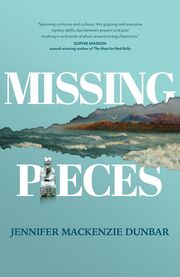Digging up the past: ‘Missing Pieces’ by Jennifer Mackenzie Dunbar
This evocative novel by Australian author Jennifer Mackenzie Dunbar is a lively combination of historical fiction, multiple timelines, and a dash of magical realism, centered around the story of the Lewis Chessmen collection.
The tiny chess pieces were discovered in 1831 on the remote Scottish island of Lewis. They have been dated to the second half of the twelfth century and were carved from walrus ivory and whale tooth.
Images of some of the pieces can be found on the British Museum’s website here. If you have a look you’ll see how intricately carved they are, with quirky, individual expressions and postures. Some pieces were included in the exhibition History of the World in 100 Objects which traveled from the Museum a number of years ago; I remember seeing these little characters in Canberra and was quite taken with them. Some pieces are in the National Museum of Antiquities of Scotland in Edinburgh.
There is much about the chessmen that is still shrouded in mystery and history, such as exactly where they were made and by whom, why they were buried, and if there are missing pieces and if so, why?
The author has made good use of the historical known facts and the remote location of the find, to weave an engaging story across three timelines and settings: Iceland in the twelfth century, Lewis Island in the nineteenth century and in 2010, and London.
The main character is Marianne, a lab assistant at the British Museum, whose master’s thesis was on cultural and national issues around the repatriation of museum artifacts to their places of origin. She is being undermined at every turn by a toxic manager; also facing a restructure of the museum’s staff, the recent trauma of her father’s death, a complicated relationship with her mother, a sad secret from her own past, and a crushing lack of confidence in her own worth and abilities.
She is sent (reluctantly) to Lewis Island to accompany twelve of the pieces from the BM, for an exhibition on the island on which they were found nearly a hundred and eighty years earlier. Here she meets several locals who give her a refreshing new way of seeing history, including her own.
Marianne sank into a warm fog, letting the music wash over her. With it came a twinge of envy for the way the locals all seemed connected to each other and to the music, joined by their history and stories of their past. An ache inside her grew.
Missing Pieces loc. 1187 of 3824 (eBook)
The story caught my attention from the start, because of the chessmen at its centre, but also its focus on issues of return of cultural artifacts. It’s a topic which has been in the news of late, including here in Australia, as many Aboriginal objects of spiritual and cultural significance have been kept in museums overseas, including the BM.
Also, I share Marianne’s mother, Shona’s, passion for family history research and was amused at the eye rolls it sometimes induces in Marianne – I am pretty sure my own interest elicits a similar response in all but fellow family historians. The time slip quality of parts of the novel appealed to the side of me that dreams of time travel (in a safe and totally reversible manner, of course!)
Most of all I enjoyed witnessing the development of Marianne from an uncertain, often prickly young woman who often feels out of her depth, to someone with more confidence in her knowledge and views and the ability to decide on her own future.
The characters are believable and relatable and the various settings of time and place brought vividly to life.
Missing Pieces is a terrific read, one I thoroughly enjoyed. It renewed my interest in the Lewis chessmen and spurred me to read more about them, and the island where they were re-discovered.
Missing Pieces was published by Midnight Sun in June 2023.
My thanks to the publisher for a review copy.
Related
You May Also Like


